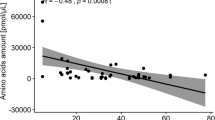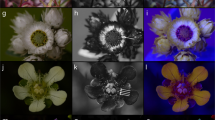The extreme length of this bat's tongue might have coevolved with the long flowers it pollinates.
Abstract
Bats of the subfamily Glossophaginae (family Phyllostomidae) are arguably the most specialized of mammalian nectarivores, and hundreds of neotropical plants rely on them for pollination1,2. But flowers pollinated by bats are not known to specialize for bat subgroups (unlike flowers that have adapted to the length and curvature of hummingbird bills, for example), possibly because the mouthparts of bats do not vary much compared with the bills of birds or the probosces of insects3,4. Here I report a spectacular exception: a recently-described nectar bat that can extend its tongue twice as far as those of related bats and is the sole pollinator of a plant with corolla tubes of matching length.
This is a preview of subscription content, access via your institution
Access options
Subscribe to this journal
Receive 51 print issues and online access
$199.00 per year
only $3.90 per issue
Buy this article
- Purchase on Springer Link
- Instant access to full article PDF
Prices may be subject to local taxes which are calculated during checkout

Similar content being viewed by others
References
von Helversen, O. & Winter, Y. in Bat Ecology (eds Kunz, T. H. & Fenton, M. B.) 346–397 (University of Chicago Press, Chicago, 2003).
Dobat, K. & Peikert-Holle, T. Bluten und Fledermause (Waldemar Kramer, Frankfurt am Main, 1985).
Stiles, F. G. Am. Zool. 18, 715–727 (1978).
Fleming, T. H., Muchhala, N. & Ornelas, J. F. in Contribuciones Mastozoológicos en Homenaje a Bernardo Villa (eds Sánchez-Cordero, V. & Medellín, R. A.) 163–186 (Instituto de Biología e Instituto de Ecología, UNAM, Mexico, 2005).
Muchhala, N., Mena, P. V. & Albuja, L. V. J. Mammal. 86, 457–461 (2005).
Herrel, A., Meyers, J. J., Aerts, P. & Nishikawa, K. C. J. Exp. Biol. 204, 3621–3627 (2001).
Winter, Y. & von Helversen, O. J. Mammal. 84, 886–896 (2003).
Griffiths, T. A. Am. Mus. Nov. 2742, 1–45 (1982).
Darwin, C. On the Various Contrivances by which British and Foreign Orchids are Fertilized (Murray, London, 1862).
Fenster, C. B. et al. Annu. Rev. Ecol. Evol. Sys. 35, 375–403 (2004).
Chan, L. K. J. Mammal. 76, 472–480 (1995).
Author information
Authors and Affiliations
Ethics declarations
Competing interests
The author declares no competing financial interests.
Supplementary information
Supplementary information
(PDF 9 kb)
Rights and permissions
About this article
Cite this article
Muchhala, N. Nectar bat stows huge tongue in its rib cage. Nature 444, 701–702 (2006). https://doi.org/10.1038/444701a
Received:
Accepted:
Published:
Issue Date:
DOI: https://doi.org/10.1038/444701a
This article is cited by
-
Three new species of Burmeistera (Campanulaceae-Lobelioideae) from Colombia
Brittonia (2013)
-
Evolutionary patterns and processes in the radiation of phyllostomid bats
BMC Evolutionary Biology (2011)
-
Have giant lobelias evolved several times independently? Life form shifts and historical biogeography of the cosmopolitan and highly diverse subfamily Lobelioideae (Campanulaceae)
BMC Biology (2009)
-
The role of Orii's flying‐fox (Pteropus dasymallus inopinatus) as a pollinator and a seed disperser on Okinawa‐jima Island, the Ryukyu Archipelago, Japan
Ecological Research (2009)
-
Associations between floral specialization and species diversity: cause, effect, or correlation?
Evolutionary Ecology (2009)
Comments
By submitting a comment you agree to abide by our Terms and Community Guidelines. If you find something abusive or that does not comply with our terms or guidelines please flag it as inappropriate.



